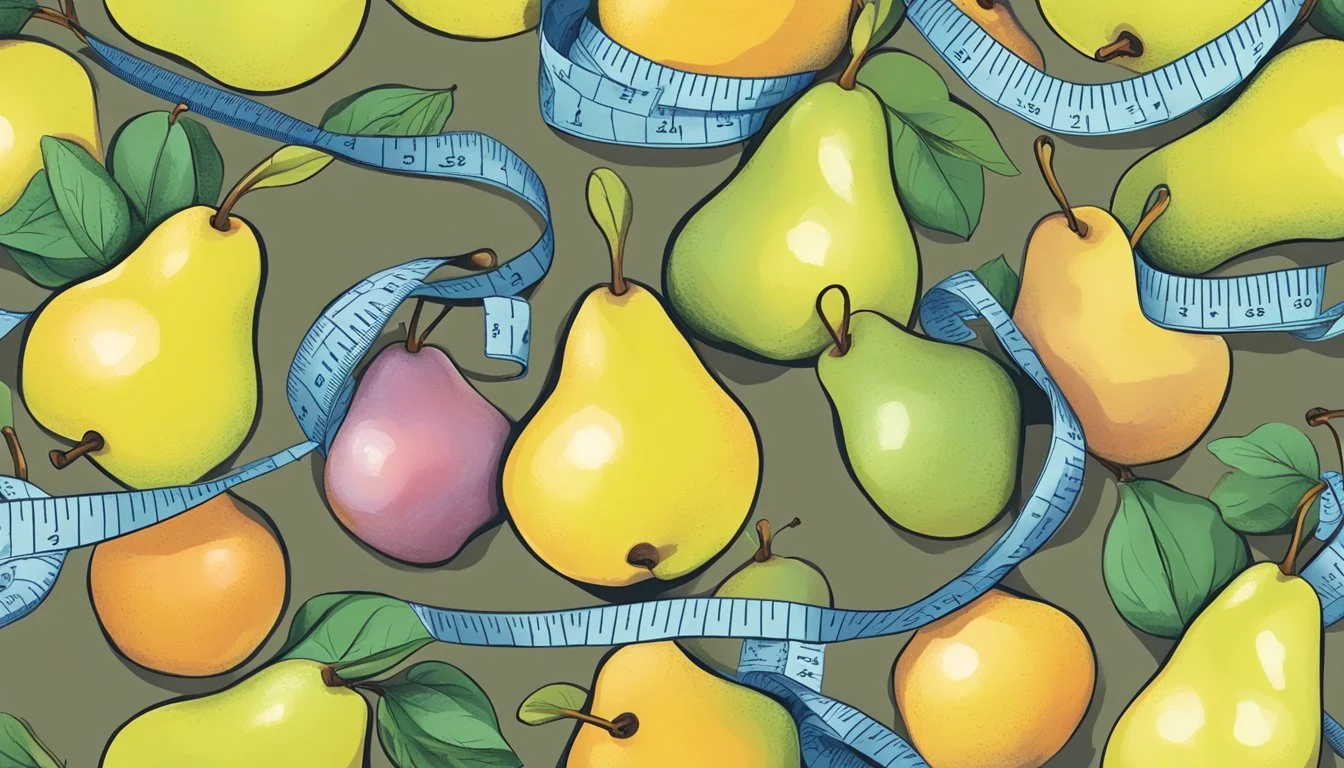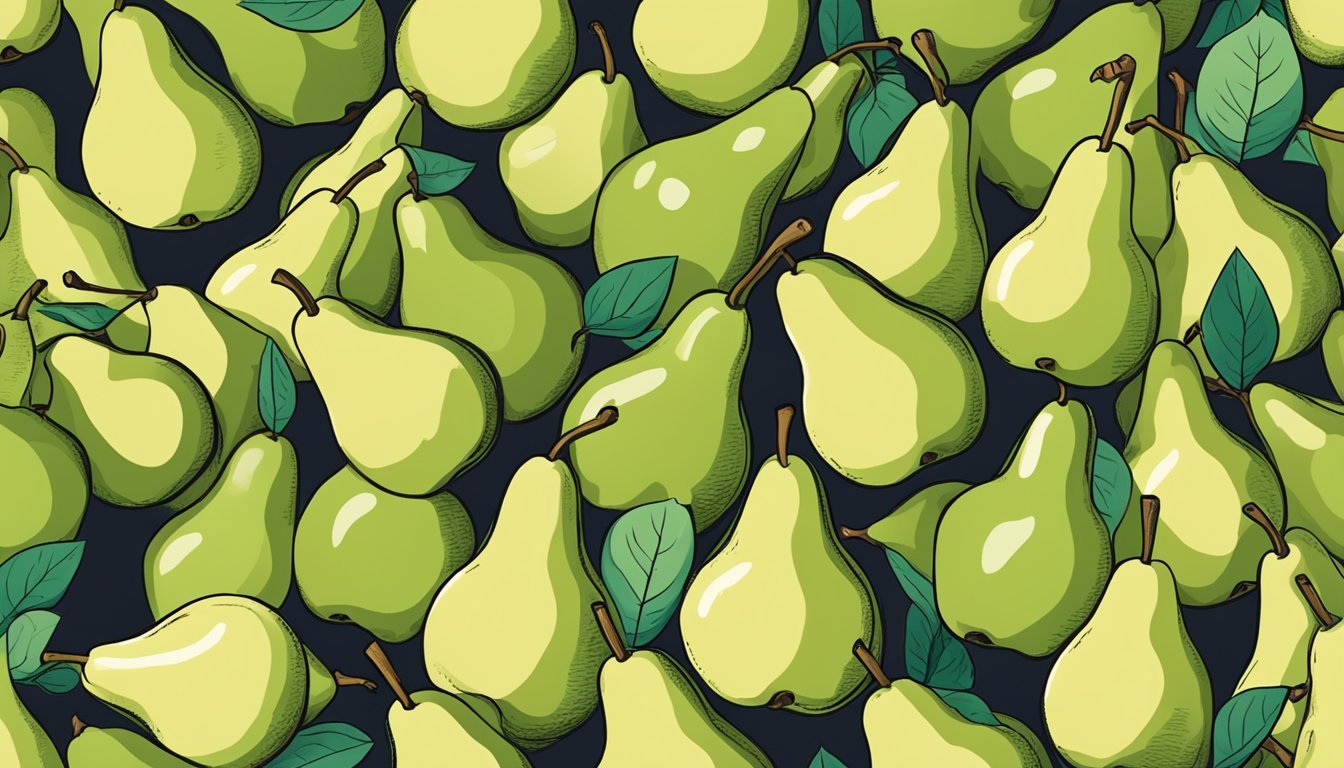How Much Pear Per Day Is Too Much?
Understanding Daily Limits
Pears are not only a tasty fruit but also a healthy addition to any diet, being a rich source of essential antioxidants, dietary fiber, and plant compounds. Their nutrient profile offers a variety of health benefits, making them a smart choice for those seeking to maintain a balanced diet. They are particularly recognized for their high fiber content, with one small pear providing about 20% of the daily fiber needs.
While enjoying pears can contribute positively to one's overall health, moderation is key, as with any food. General dietary guidelines suggest consuming two servings of fruit per day, with one serving of fruit being equivalent to one medium pear. Consuming too many pears could contribute to excessive sugar intake and potentially upset the balance of a well-rounded diet. Therefore, it's judicious to consider the quantity of pears consumed within the context of an individual's total daily fruit intake and energy requirements.
Individual dietary needs can vary based on factors like age, sex, level of physical activity, and overall health. Most healthy adults require at least 28 grams of fiber per day as part of a 2000-calorie diet; however, the ideal fruit intake can differ from person to person. Health professionals typically recommend tailoring fruit consumption to one's specific nutritional needs and health goals, ensuring that the benefits of fruits like pears are maximized without overconsumption.
Nutritional Profile of Pears
Pears are recognized for their high fiber content, substantial vitamin and mineral provision, and reasonable caloric profile which varies slightly across different varieties. Each pear variety offers a unique nutritional composition that contributes to a balanced diet.
Vitamins and Minerals in Pears
Pears are a good source of several essential nutrients. They contain:
Vitamin C: Essential for immune function and skin health, pears provide about 8% of the daily value per medium-sized fruit.
Vitamin K: Important for blood clotting, with each pear offering a minor proportion of the recommended daily intake.
Potassium: Which supports heart health, providing a moderate amount per pear.
Small quantities of Vitamin A and Vitamin E are also present, alongside other minerals which contribute to overall health.
Fiber Content and Its Benefits
The fiber content in a medium-sized pear is impressive, with one providing approximately:
6 grams of dietary fiber, equating to about 21% of the daily recommended value.
The majority of this fiber is contained in the pear's skin. Dietary fiber aids in digestion, helps maintain steady blood sugar levels, and supports a feeling of fullness, which can assist in weight management.
Caloric Value of Different Pear Varieties
Pears are a low-calorie fruit choice, making them suitable for a weight-conscious diet, with the average caloric content per variety as follows:
A standard medium-sized pear: 100-101 calories.
Asian pears: Notably fewer calories and higher in vitamin C than other types.
Within the broad array of pear varieties, the calorie count can fluctuate slightly, but they typically remain a low-calorie option rich in nutrients and fiber.
Health Implications of Pear Consumption
Pears are a nutritious fruit that can have several health implications when consumed, including aiding digestive health, managing blood sugar levels, providing cardiovascular benefits, and potentially supporting weight loss efforts.
Impact on Digestive Health
Pears are rich in dietary fiber, which is essential for maintaining good digestive health. They contain both soluble and insoluble fiber; the latter is particularly beneficial in preventing constipation. Regular consumption of pears may facilitate bowel regularity and contribute to a well-functioning digestive system.
Pears and Blood Sugar Management
The fiber in pears can also help regulate blood sugar levels. Pears have a low glycemic index, meaning they release glucose into the bloodstream at a slower rate. This potentially makes them a suitable fruit choice for those monitoring their blood sugar, such as individuals with diabetes.
Cardiovascular Benefits
Including pears in one's diet may confer cardiovascular advantages. The fiber found in pears can bind to cholesterol particles and aid in their removal from the body, thereby contributing to lowered cholesterol levels. This process can reduce the risk of heart disease.
Associations With Weight Loss
Pears have qualities that support weight management strategies. Their fiber content promotes feelings of fullness, which may lead to a reduction in overall calorie intake. Some studies suggest that increased pear consumption is associated with a lower waist circumference, indicating a potential role in weight loss endeavors.
Daily Recommendations and Overconsumption
Eating pears contributes to daily fruit intake with benefits such as dietary fibers and essential nutrients. However, excessive consumption may have drawbacks worth consideration.
Optimal Daily Intake of Pears
The general guideline for fruit consumption, which includes pears, is at least 400 grams per day, or roughly two medium-sized fruits. Pears are a low-glycemic fruit, meaning they have a minimal impact on blood sugar levels. They are rich in dietary fibers, which are crucial for digestive health. The fiber content for an average pear is about 6 grams, contributing significantly to the daily recommended fiber intake, which is 25.2 to 28 grams for women and 28 to 34 grams for men, depending on age and activity level.
Risks of Eating Too Many Pears
While pears offer numerous health benefits, there are risks associated with overconsumption:
Sugar Content: Pears contain natural sugars, and eating them in excessive amounts can lead to increased calorie intake and potential weight gain.
Gastrointestinal Distress: High fiber intake, especially when a person is not accustomed to it, can cause bloating, gas, and stomach pain.
Nutrient Imbalance: Overeating pears can lead to an imbalance, as it might displace other vital nutrients and food groups from one's diet.
Each individual's tolerance to fruit sugar and fiber varies, so it is crucial to listen to one's body and adjust the intake accordingly.
Comparative Analysis
This section evaluates pears in relation to other fruits and processed snacks, focusing on nutritional content and potential health implications.
Pears vs Other Fruits
Pears are often compared to apples since they're both low in calories, and have similar fiber content and low glycemic index values. A medium-sized pear contains about 6 grams of fiber and has a glycemic index of 38, which is slightly higher but still comparable to the glycemic index of apples at 36. Both fruits are good sources of vitamins and antioxidants. However, the variety of pear can affect its nutritional value; for instance, D'Anjou, Bartlett, Bosc, and Comice pears all offer different levels of sweetness, juiciness, and nutrients.
Fruit Glycemic Index Fiber (grams per medium fruit) Calories Pear 38 6 100 Apple 36 4.4 95
Pears vs Processed Snacks
Processed snacks typically contain added sugars and preservatives, features that can negatively impact an individual's health if consumed in excess. Pears, as a natural snack option, offer nutritional benefits without these unhealthy additives. They are particularly noted for their fiber content, which not only aids in digestion but also contributes to the feeling of fullness. When comparing a medium-sized pear to a standard processed snack, the pear provides a healthier alternative with essential nutrients and without added sugars.
Snack Type Added Sugars (grams) Fiber (grams) Calories Medium-sized Pear 0 (natural sugars) 6 100 Processed Snack Varies Low/Varies Varies
Pears offer a natural, fiber-rich alternative to processed snacks and hold their own against other popular fruits like apples.
Incorporating Pears into Your Diet
Pears are a versatile fruit that can easily be included in one's daily diet. They are not only nutritious but also offer a variety of ways to enhance meals with their sweet, mild flavor.
Simple Pear Recipes for Daily Use
One can incorporate pears into their diet through simple recipes that require minimal preparation. Here are a few quick ideas:
Morning Kickstart: Slice a pear and add it to your morning oatmeal or cereal. Sprinkle with cinnamon for added flavor.
Smooth Transition: Blend pears into smoothies for a nutritious and fiber-rich drink.
Pear Salad Boost:
Dice and toss pears into salads for a sweet contrast to leafy greens.
For a heartier option, combine with walnuts and feta cheese.
Suggestions for Pear Consumption
To optimize the inclusion of pears in one's diet, consider the following:
Moderation:
Aim for about one medium-sized pear per day to balance sugar intake with the benefits of fiber and nutrients.
Pairing for Taste:
Complement the taste of pears by pairing with cheeses or nuts in snacks.
Pears can also be baked or poached, and served with a scoop of yogurt for a healthy dessert.
By following these straightforward tips, pears can become a delightful part of one's daily diet, contributing to overall health and adding a touch of sweetness to various meals.
Addressing Potential Health Concerns
When considering the health impacts of pear consumption, it’s important to be aware of potential allergies and the effects of pears on specific conditions. Pears are generally beneficial, but they can pose risks for individuals with certain health issues or allergies.
Pears and Allergies
Pears, like other fruits, have the potential to trigger allergic reactions in some individuals. These reactions can range from mild oral allergies to more severe systemic responses. Symptoms of a pear allergy may include itching or swelling around the mouth, hives, or difficulty breathing. Individuals with a known fruit allergy should consult with a healthcare professional before adding pears to their diet.
Effects of Pears on Specific Conditions
Pears contain various nutrients that can affect health conditions differently. Below is a brief overview of the impacts pears may have on certain health concerns:
Diabetes: Pears have a low glycemic index and are rich in fiber, which can help regulate blood sugar levels, making them a suitable option for individuals managing type 2 diabetes.
High Blood Pressure: The potassium found in pears may assist in lowering high blood pressure, as it helps to balance sodium levels in the blood.
Metabolic Syndrome: Regular pear consumption, as part of a healthy diet, may contribute to a reduced risk of metabolic syndrome, which is associated with conditions like inflammation and high blood sugar.
Cancer: While pears are not a cure for cancer, their fiber content and antioxidants may support overall health and could play a role in cancer prevention.
Diverticular Disease: The dietary fiber in pears can help promote bowel regularity and may reduce the risk of developing diverticular disease.
Irritable Bowel Syndrome (IBS): For some people with IBS, pears may exacerbate symptoms due to their fructose content. It's advisable to consume them in moderation and observe the body’s response.
People with these conditions should discuss their fruit intake, including pears, with their healthcare provider to tailor their diet to their specific health needs.
Pear Varieties and Their Unique Qualities
Pears come in a wide array of varieties, each with distinctive taste profiles and textures that cater to different preferences and culinary uses.
Differences in Taste and Texture
Anjou Pears
Taste: Mildly sweet and slightly tangy
Texture: Firm and dense, making them versatile for both eating raw and cooking
Bartlett Pears
Taste: Signature pear flavor that is exceptionally sweet
Texture: Soft and juicy when ripe, ideal for eating fresh or for canning
Bosc Pears
Taste: Sweet with a hint of spiciness
Texture: Crisp and firm, suitable for cooking or baking as they hold their shape well
Comice Pears
Taste: Very sweet and rich
Texture: Creamy and tender, often preferred for fresh eating or pairing with cheese
Concorde Pears
Taste: Vanilla-sweet flavor that intensifies when the pear is fully ripe
Texture: Firm to the bite at the stem, tender at the opposite end
Forelle Pears
Taste: Sweet and slightly tangy, with a hint of cinnamon
Texture: Crisp and grainy, recognized by their small size and unique coloring
Seckel Pears
Taste: Bite-sized with an intense sweetness
Texture: Firm and dense, Seckels are often called "sugar pears"
Asian Pears
Taste: More similar to apples with a refreshing sweetness
Texture: Always crisp, irrespective of their ripeness
Prickly Pear
Taste: Exotic and melon-like with a natural sweetness
Texture: Moist and chewy with edible seeds inside, unlike typical pears
Seasonality of Different Pear Types
Fall Varieties: Bartlett pears are the first to be harvested in late summer to early fall; their sweetness symbolizes the onset of the pear season.
Winter Varieties: Anjou, Bosc, and Comice pears are harvested in the fall but available through the winter months due to their higher storage tolerance.
Both Asian pears and prickly pears are exceptions, as Asian pears are available almost year-round due to various seasonal varieties, and prickly pears are typically harvested in late summer to early fall.
Pears in Different Cultures
Pears hold a varied and impressive presence worldwide, celebrating their cultural significance and rich variety.
Pear Varieties Around the World
Throughout the globe, thousands of pear varieties flourish, with each region boasting its own preferred types. In Europe, cultivars such as the Conference and Comice are widely appreciated for their juicy, sweet flavors, high water content, and substantial dietary fiber. The United States favors varieties like Anjou, Bartlett, and Bosc for their distinctive textures and tastes.
Europe: Conference, Comice
United States: Anjou, Bartlett, Bosc
Historical Significance of Pears
Pears have a lengthy historical presence, with their cultivation dating back to ancient civilizations. In Europe, they were highly esteemed by the Romans, who developed techniques for their cultivation and valued them for both their taste and high dietary fiber content. By the Middle Ages, pears had become an integral part of European diet and culture, with documentation showing that many varieties were selectively bred for improved quality and to suit different climates.
Ancient Rome: Advanced pear cultivation
Middle Ages: Selective breeding and widespread culinary use
Scientific Research on Pears
Scientific studies on pears have uncovered their significant antioxidant properties and potential implications on chronic diseases.
Studies on Antioxidant Properties
Researchers have identified pears as a rich source of various antioxidants, which are essential for combating oxidative stress in the body. These antioxidants include flavonoids, anthocyanins, and vitamin K, along with a host of other phytonutrients. A particular focus has been on pear peels, which have been shown to have more concentrated lipid-lowering plant compounds than the fruit's pulp. Specifically, the presence of catechin, a type of polyphenol, is more abundant in the peels and is associated with these health effects.
Research on Pears and Chronic Diseases
Pears are high in dietary fiber, which can have a positive impact on digestive health and potentially aid in the regulation of plasma lipids. The high fiber content corresponds to the fruit's laxative properties. Additionally, studies suggest that the anti-inflammatory properties of pears may contribute to the prevention of certain chronic diseases. Various polyphenols found in pears, which are a part of the broader category of phytonutrients, have been studied for their role in protecting against ulcers and regulating alcohol metabolism. However, the protein content in pears is generally low compared to other essential nutrients present in the fruit.
Conclusion
Eating pears can contribute positively to one’s health, but moderation is key. The ideal consumption rate aligns with general fruit intake recommendations, which is typically two servings of fruit per day. A single medium-sized pear qualifies as one serving.
Pears offer nutrients that support the immune system, including vitamin C and antioxidants. Additionally, their gut health benefits are notable due to their rich fiber content, promoting a healthy digestive system and potentially aiding in the prevention of digestive-related diseases.
Recommended Pear Intake:
Adults: 1 medium-sized pear per day
Children: Half a pear may suffice, considering their smaller stomach capacity and nutritional requirements.
Exceeding this amount is not typically advised, as excessive consumption could lead to digestive discomfort, particularly for individuals with sensitivities.
For maintaining balance, it is also important to include a variety of other fruits and vegetables in one’s diet. Pears should be integrated as part of a diverse and balanced intake to ensure a broad spectrum of nutrients support overall health.











